Entering the world of special effects — or SFX — make-up can be daunting. There are tons of different types of prosthetics and make-up, adhesives, tools, and other options out there. It can be overwhelming… so let me break down some of the options when it comes to prosthetic adhesives and the pros and cons of each.
PSA:
Before we get going, just a word of warning. There are tons of tutorials out there that recommend a lot of “DIY” or “budget” options — please exercise extreme caution in using things on your body that have not been explicitly tested for long term use in that way.
Budget Options:
Eyelash Glue
Available at convenience stores all the way up to specialty stores, the benefits of using eyelash glue include its availability and cheap price point, as well as the fact that it’s a double-hitter since most women will already be using it. However, it is probably the weakest of all glues and is not suitable for anything large, any points of stress, or all day wear.
Pros: readily available, cheap, comes in clear as well as black colors, generally safe for use anywhere on the body, can be used to fill edges or gaps
Cons: many kinds are liquid latex so may cause allergic reactions, not very strong, will not hold up to weight or stress, quickly weakened by sweat, sold in very small volumes
To use: apply a thin layer of eyelash glue to the underside of prosthetic. Allow fifteen to thirty seconds to get tacky before pressing into place. Do not adjust.
Recommended Product: https://amzn.to/2YwwmZp
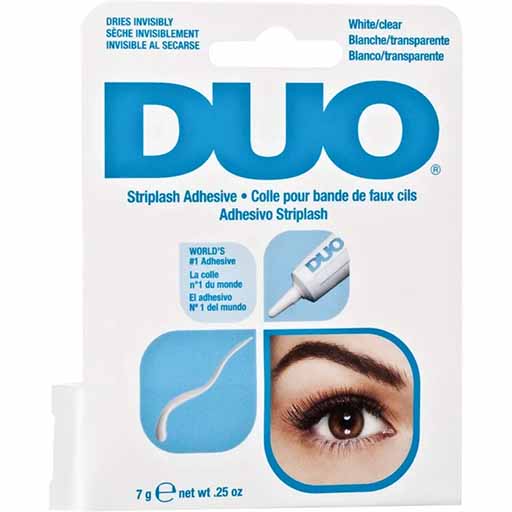
Spirit Gum
Found at any costuming store, spirit gum is especially prevalent and easy to find around Halloween. The ubiquitous first go-to, this is a general glue that can be used to glue most small to medium horns and many latex appliances, but is the weakest of all glues and may fail, especially some of the cheaper brands.
Pros: easy to find, especially around Halloween; safe for resin and latex appliances; can also be used to hold on glitter or other make-up pigments; good starter glue
Cons: will not hold silicone; generally weak and may not hold for all day cons; leaves a residue that needs remover to eliminate fully; some kinds may cause allergic reactions; sweat will quickly weaken
To Use: apply a thin layer of glue to the appliance and the skin where you wish to glue the appliance; allow to get tacky before pressing appliance in place.
Recommended Product: https://amzn.to/2YwwqZ9

Elmer Stick Glue
The purple kind! A drag queen’s best friend, the stick glue is the easiest and most tried and true way of hiding hair especially eyebrows. Can also be used in a pinch to help hide appliance seamlines.
Pros: available almost everywhere; cheap; reliable with many tutorials available
Cons: will not hold prosthetics on; sweat will remove; very slow to build up edge fillers
To Use: brush glue into hair and comb hair flat. Allow to dry fully (glue will become transparent). Apply another layer of glue in perpendicular direction, setting each layer with powder. Layer until smooth, then apply foundation over top to hide hair fully.
Recommended Product: https://amzn.to/2Muc6l4
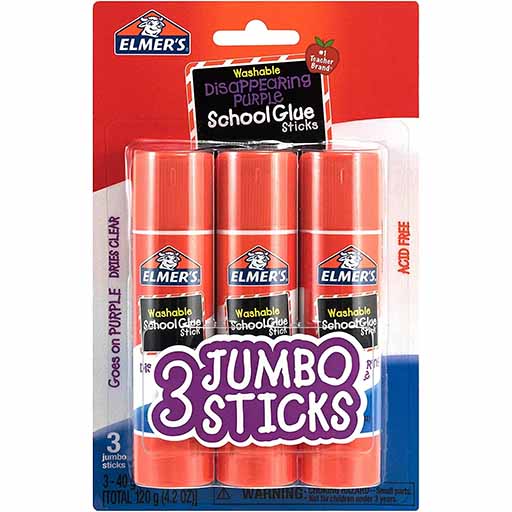
Liquid Latex
An absolute staple in every sfx make-up artist’s handbag, liquid latex is most commonly used for creating prosthetics and building up looks, but can also be used to glue pieces on and fill edges. It has a bit of a learning curve so I recommend practice, practice, practice.
Pros: available at most costuming shops; long lasting; appropriate for a variety of uses besides just adhering; can easily be painted or shaded to match skin
Cons: can be expensive for larger batches; allergies to this are very common and can range from mild to extreme; very difficult to work with; not a strong hold; sweat will weaken
To Use: To glue prosthetics on, dab a bit of latex onto the prosthetic. Apply to skin and hold securely for 30seconds to five minutes (depending on the size of prosthetic) to allow latex to fully dry. To use for edge filling, use a popsicle stick, back of spoon, or makeup spatula to press the latex up into the edge a little bit at a time, allowing full time to dry in between coats. Set with powder and then paint or apply foundation on top.
Recommended Product: https://amzn.to/2ypdw7Z
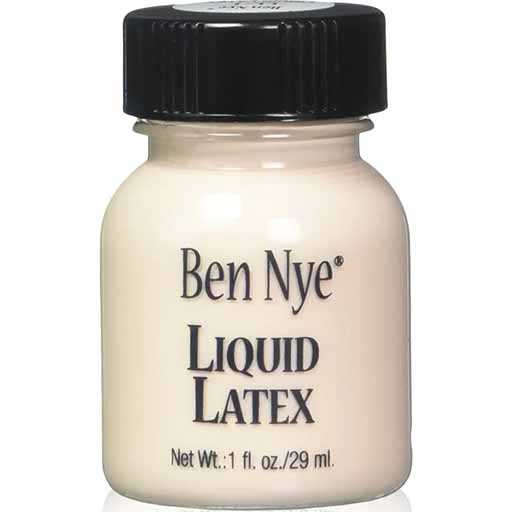
Better Options:
Ben Nye Prosthetic Adhesive
A step up from spirit gum, Ben Nye makes their own prosthetic adhesive that I tend to use instead of regular Spirit Gum as it’s a more secure hold but not as locked down as the next step in strength.
Pros: available at most costuming stores and online; fairly cheap for its size; skin safe and not likely to cause a reaction; stronger hold than basic spirit gum;
Cons: may leave a residue that needs to be cleaned with remover; sweat will weaken it
To Use: Apply a thin layer of prosthetic adhesive to the prosthetic then to clean skin. Allow to get mostly dry before pressing prosthetic into place. Do not shift.
Recommended Product: https://amzn.to/2SRZ8i1
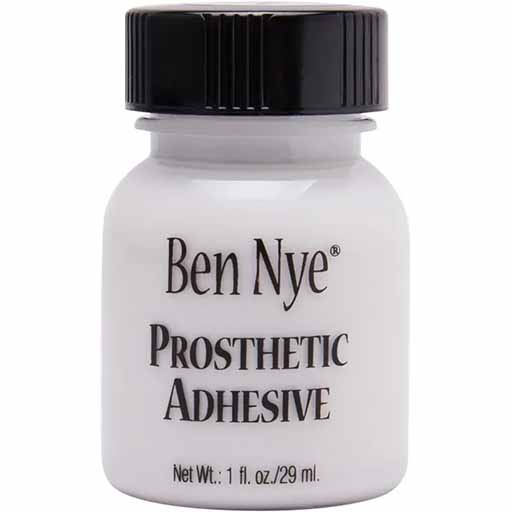
ProsAide Glue
My go-to for most prosthetics and all day wear, Pros-Aide was designed to hold medical devices on all day long, and thus is very skin safe as well as sturdy. It is the most resistant of all glues to perspiration and sweat and a great choice in most situations.
Pros: very strong and will hold most appliances all day; can be used to hold latex, resin, foam, and even fabric to the skin; very unlikely to have an allergic reaction; skin safe for wear all day and repeatedly
Cons: can be difficult to find, usually needs to be ordered online; using this in sensitive areas does require the use of remover; leaves a stubborn residue behind that does not wash off easily
To Use: Apply a thin layer of glue to prosthetic, then another to skin. Allow to dry almost completely before applying prosthetic. Do not readjust prosthetic.
Recommended Product: https://amzn.to/2LQkyLS

For Silicone Prosthetics:
Skin Tite
Silicone prosthetics are much more rare than latex and generally have very specific applications or reasonings. They are not recommended for beginners, but if you do find yourself with a silicone prosthetic, the go-to adhesive is Skintite.
Pros: works with silicone; very secure; extremely unlikely to have allergic reactions to; extremely flexible; can be used to build up scars or other small details; is highly flexible for areas of high stress or movement; sweat resistant
Cons: very limited use beyond silicone; more expensive; must be ordered from one company
To Use: mix Skin Tite together per instructions on packaging. Apply to skin and then apply prosthetic; hold until Skin Tite is cured (up to five minutes).
Recommended product: https://amzn.to/2SWT1sH
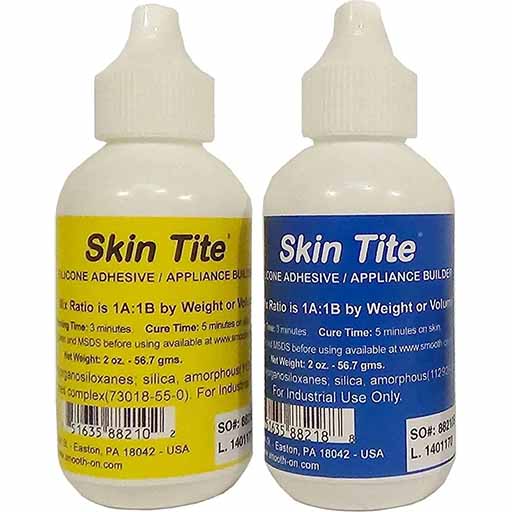
There you go! An overview of some of the most commonly available and commonly used adhesives out there. Feel free to experiment and discover which suit your needs best — and, as always, cosplay on!





